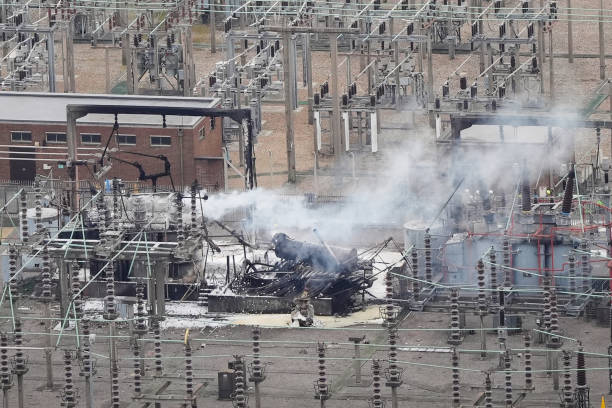
The Heathrow Transformer Explosion: A Preventable Disaster?
How H2scan’s hydrogen monitoring technology can help get in front of potential transformer failures.
On March 20, 2025, at 23:23 GMT, a catastrophic fire erupted at the North Hyde electrical substation in Hayes, north of Heathrow Airport. The high-voltage transformer explosion severed power to Europe’s busiest airport and over 63,000 homes, disrupted more than 1,350 flights, and caused economic losses estimated at £60-120 million (~$70-150 million US) in just one day. The airport remained shuttered for 18 hours, with approximately 150 people evacuated from properties surrounding the substation.
But what if this disaster could have been prevented?
In fact, the electrical power industry has begun to adopt new hydrogen sensing transformer monitors that acts as an early warning system for liquid-filled transformer operating health.
As a leading producer of high-performance hydrogen sensor solutions, H2scan’s patented, proven technology is today used by utilities for transformer management, by the chemical industry to optimize hydrogen processes, and for safety monitoring in enclosed areas such as data centers and battery energy storage rooms where the presence of hydrogen leaks occur.
The Heathrow incident, while still under investigation at this writing, highlights three critical issues:
- The need to operate transformers at or beyond their limits to meet demand
- The worldwide aging condition of transformers
- The global shortage of new electrical transformers that currently stretches to a two-year period
These factors have prompted progressive power utilities and industrial transformer owners to implement early detection programs using hydrogen-based single gas transformer monitors.
Hydrogen is the first gas released during a transformer abnormality, so monitoring hydrogen production in a transformer is a reliable indicator of evolving issues. It is produced 3-10x faster than other gases during thermal and electrical events. Its low oil solubility causes rapid migration through the insulating fluids, making it the ideal early warning indicator. Many transformer operators are now implementing single gas transformer monitors as part of their fleet management initiatives, one intended to extend transformer lifespans.
“While we don’t know the precise cause of this transformer failure, we do know that many progressive power utilities and transformer operators have begun to rely upon single gas monitoring, a cost effective technology that brings the visibility needed to avoid catastrophic failures of all transformers,” said H2scan CEO David Meyers.
H2scan, the world’s leading hydrogen sensor provider with more than 700 million hours of transformer monitoring experience, offers proven technology that utilities and industrial transformer operators rely upon to detect faults weeks before failure to identify transformers that require preventative maintenance.
The Anatomy of a Disaster
Investigation into the root cause of the Heathrow failure is under way, but likely causes reported by the UK press points to several potential contributing factors:
- Demand growth: It is not uncommon for substations to be operating beyond their rated capacities; the North Hyde substation had previously been reported as running at 106.2% of its capacity.
- Aging infrastructure: The transformer was reported as being very old, and as transformers age, the insulation material ages.
- Insulation breakdown: The transformer is believed to have experienced a catastrophic insulation failure, causing severe arcing that ignited the 6,600 gallons (US) of insulating liquid (oil).
- Insufficient redundancy: Despite Heathrow relying on three substations, it appears that the North Hyde failure exposed flaws in the backup schema.
“Based on what we have read, The the transformer likely would have experienced progressive deterioration before catastrophic failure, and H2scan’s continuous monitoring would have detected the buildup of hydrogen and alerted authorities to the impending failure in advance” Meyers went on to say.
H2scan’s new GRIDSCAN family of transformer monitors contains advanced monitoring and alert features that are critical for those charged with transformer health. For the first time, this level of proactive monitoring is both effective as well as affordable to deploy on a widespread basis throughout an entire transformer fleet:
- Early Hydrogen Detection: The solid-state hydrogen sensor detects concentrations as low as 25 ppm—the earliest sign of developing faults
- Multi-Parameter Confirmation: The system correlates hydrogen readings with:
- Moisture increases: Indicating insulation breakdown
- Temperature anomalies: Revealing hotspots from arcing
- Pressure changes: Signaling gas accumulation or liquid leakage
- Real-Time Alerts: The system can immediately notify operators via SCADA/ADMS integration
- Trend Analysis: H2scan’s analytics shows the accelerating rate of hydrogen generation, identifying the severity and urgency of an impending fault
- Planned Intervention: This level of fleet-wide monitoring indicates when maintenance is required, allowing time-stretched operations teams to schedule transformer upgrades conveniently during low-demand periods, avoiding the unplanned, emergency shutdowns and losses that can be as much as $9,000 US per minute according to some studies.
Real-World Impact: A Case Study of Hydrogen Monitoring in the Field
A Caribbean utility deployed the company’s earlier-generation GRIDSCAN 5000 on a 24 KVA transformer, that detected the rapid production of hydrogen. Laboratory analysis confirmed these readings, and inspection of the transformer revealed severe winding damage. The transformer was replaced before catastrophic failure, minimizing the safety risk and avoiding the time and cost to replace the transformer.
Beyond Simple Detection
GRIDSCAN provides detailed insights without requiring transformer outages or physical access to internal components.
The true cost of aging grid infrastructure isn’t just maintenance—it’s the catastrophic failures that result from failing to act on information that could have been provided from monitoring.
Conclusion: A Call to Action
The Heathrow transformer explosion stands as a stark reminder of the potential advantage of incorporating innovation in critical infrastructure monitoring. As utilities face increasing pressure to maintain aging infrastructure while supporting decarbonization initiatives, technologies like H2scan’s represent not just a safety enhancement but an economic imperative.
